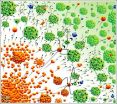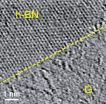(Press-News.org) For purposes of their research, the scientists irradiated two separate layered systems with ultrashort laser pulses on the order of just one hundred femtoseconds (10-15 s). One sample consisted essentially of a single thin layer of ferromagnetic nickel. By contrast, a second sample of this same nickel material was coated with a non-magnetic layer of gold. Only a mere 30 nanometers (10-9 m) thick, the gold layer swallowed up the lion's share of the laser light so that barely any light ended up reaching the nickel layer. In spite of this, the nickel layer's magnetization rapidly dissipated shortly after the laser pulse entered each sample. However, in the case of the gold-coated sample, the researchers recorded a split-second delay. The observations were based on measurements obtained using circularly polarized femtosecond x-ray pulses at BESSY II, Berlin's own electron storage ring, with the help of the femtoslicing beamline.
"This allowed us to demonstrate experimentally that during this process, it isn't the light itself that is responsible for the ultrafast demagnetization but rather hot electrons, which are generated by the laser pulse," explains Andrea Eschenlohr. Excited electrons are able to rapidly move across short distances - like the ultra-thin gold layer. In the process, they also deliver their magnetic moment (their "spin") to the ferromagnetic nickel layer, prompting the breakdown of the latter's magnetic order. "Actually, what we had hoped to see is how we might be able to influence the spin using the laser pulse," explains Dr. Christian Stamm, who heads the experiment. "The fact that we ended up being able to directly observe how these spins migrate was a complete surprise to everyone."
Laser pulses are thus one possibility to generate "spin currents" where the spin is transferred in place of an electric charge. This observation is relevant for spintronics research where scientists design new devices from magnetic layered systems, which perform calculations based on spins rather than electrons, enabling them to very quickly process and store information while at the same time saving energy.
Dr. Eschenlohr concluded her doctoral work at HZB, in the context of which she generated the results described above, in late 2012. As of January of this year, Dr. Eschenlohr is a scientific associate at University of Duisburg-Essen.
###The paper "Ultrafast spin transport as key to femtosecond demagnetization" will be published on 27. January 2013, 18:00 London time (GMT), in Nature Materials with doi: 10.1038/nmat3546.
For additional information please contact Dr. Christian Stamm,
Methods and Instrumentation for Synchrotron Radiation Research
Phone: +49 (0)30-8062-14887
E-mail: christian.stamm@helmholtzberlin.de
Demagnetization by rapid spin transport
2013-01-28
ELSE PRESS RELEASES FROM THIS DATE:
Accelerating neutral atoms on a table top
2013-01-28
Charged particle accelerators have become crucially important to modern day life, be it in health care for cancer treatment or for answering important fundamental scientific questions like the existence of the HIGGS boson, the so called 'God particle'. In a simple picture, charged particles like electrons and protons are accelerated between two end plates across which an electrical voltage is applied. High energies need high voltages (millions and billions of volts) and long acceleration paths in giant sized machines – for instance the trillion volt machine called the 'large ...
Rice technique points toward 2-D devices
2013-01-28
HOUSTON – (Jan. 28, 2013) – Rice University scientists have taken an important step toward the creation of two-dimensional electronics with a process to make patterns in atom-thick layers that combine a conductor and an insulator.
The materials at play – graphene and hexagonal boron nitride – have been merged into sheets and built into a variety of patterns at nanoscale dimensions.
Rice introduced a technique to stitch the identically structured materials together nearly three years ago. Since then, the idea has received a lot of attention from researchers interested ...
Cities affect temperatures for thousands of miles
2013-01-28
BOULDER – Even if you live more than 1,000 miles from the nearest large city, it could be affecting your weather.
In a new study that shows the extent to which human activities are influencing the atmosphere, scientists have concluded that the heat generated by everyday activities in metropolitan areas alters the character of the jet stream and other major atmospheric systems. This affects temperatures across thousands of miles, significantly warming some areas and cooling others, according to the study in Nature Climate Change.
The extra "waste heat" generated from ...
Stem cells aid recovery from stroke
2013-01-28
Stem cells from bone marrow or fat improve recovery after stroke in rats, finds a study published in BioMed Central's open access journal Stem Cell Research & Therapy. Treatment with stem cells improved the amount of brain and nerve repair and the ability of the animals to complete behavioural tasks.
Stem cell therapy holds promise for patients but there are many questions which need to be answered, regarding treatment protocols and which cell types to use. This research attempts to address some of these questions.
Rats were treated intravenously with stem cells or ...
Measuring the consequence of forest fires on public health
2013-01-28
Pollution from forest fires is impacting the health of people with asthma and other chronic obstructive lung diseases, finds a study in Biomed Central's open access journal Environmental Health. This study uses data from pharmacies and dispensaries to measure the increase in drugs needed to alleviate symptoms associated with pollution.
Forest fires burn nearly 1000 km2 of trees in British Columbia every year. The Ministry of Environment keeps a close watch on levels of particulate matter in the air caused by these fires but it is harder to measure the impact of this ...
Poor sleep in old age prevents the brain from storing memories
2013-01-28
The connection between poor sleep, memory loss and brain deterioration as we grow older has been elusive. But for the first time, scientists at the University of California, Berkeley, have found a link between these hallmark maladies of old age. Their discovery opens the door to boosting the quality of sleep in elderly people to improve memory.
UC Berkeley neuroscientists have found that the slow brain waves generated during the deep, restorative sleep we typically experience in youth play a key role in transporting memories from the hippocampus – which provides short-term ...
In breast cancer metastasis, researchers identify possible drug target
2013-01-28
The spread of breast cancer to distant organs within the body, an event that often leads to death, appears in many cases to involve the loss of a key protein, according to UC San Francisco researchers, whose new discoveries point to possible targets for therapy.
In the January 27, 2013 online edition of Nature Cell Biology, UCSF scientists describe for the first time how the protein, known as GATA3 — which is abnormal or absent in many cases of human breast cancer — normally acts downstream in biochemical pathways to prevent the distant spread of cancer, an event called ...
Less invasive treatment may increase survival in early stage breast cancer
2013-01-28
DURHAM, N.C. -- Patients with early stage breast cancer who are treated with lumpectomy plus radiation have a better chance of survival compared with those who undergo mastectomy, according to Duke Medicine research.
The study, which appears online Jan. 28, 2013, in the journal CANCER, demonstrates the effectiveness of breast-conserving therapies such as lumpectomy, where only the tumor and surrounding tissue are surgically removed.
"Our findings support the notion that less invasive treatment can provide superior survival to mastectomy in stage I or stage II breast ...
Better survival rates seen with lumpectomy compared with mastectomy for early breast cancer
2013-01-28
A new analysis has found that lumpectomy plus radiation for early breast cancer may provide patients with a better chance of survival than mastectomy. Published early online in CANCER, a peer-reviewed journal of the American Cancer Society, the results provide confidence in the efficacy of breast-conserving treatments even among patients with aggressive, early disease.
Lumpectomy combined with radiation is a good treatment choice for women with early breast cancer; however, over the past 10 years, a growing number of women have been choosing mastectomy even for very small ...
First guidelines for brain amyloid imaging in Alzheimer's released
2013-01-28
CHICAGO, January 28, 2013 – Only recently has it become possible to create high-quality images of the brain plaques characteristic of Alzheimer's disease in living people through positron emission tomography (PET). Even so, questions remain about what can be learned from these PET images and which people should have this test.
To provide guidance for physicians, individuals and families affected by Alzheimer's, and the public, the Society of Nuclear Medicine and Molecular Imaging (SNMMI) and the Alzheimer's Association have jointly published the first criteria for the ...



